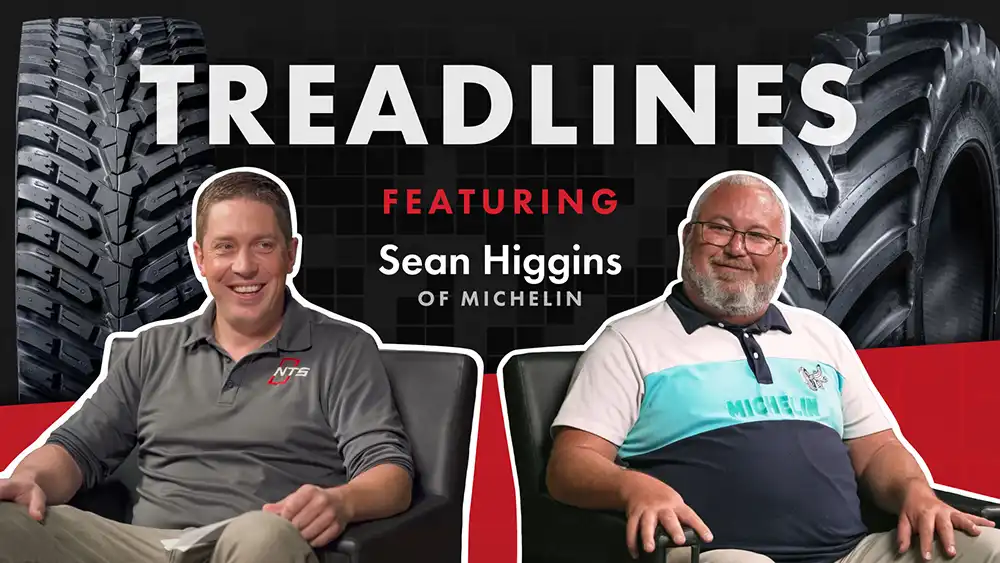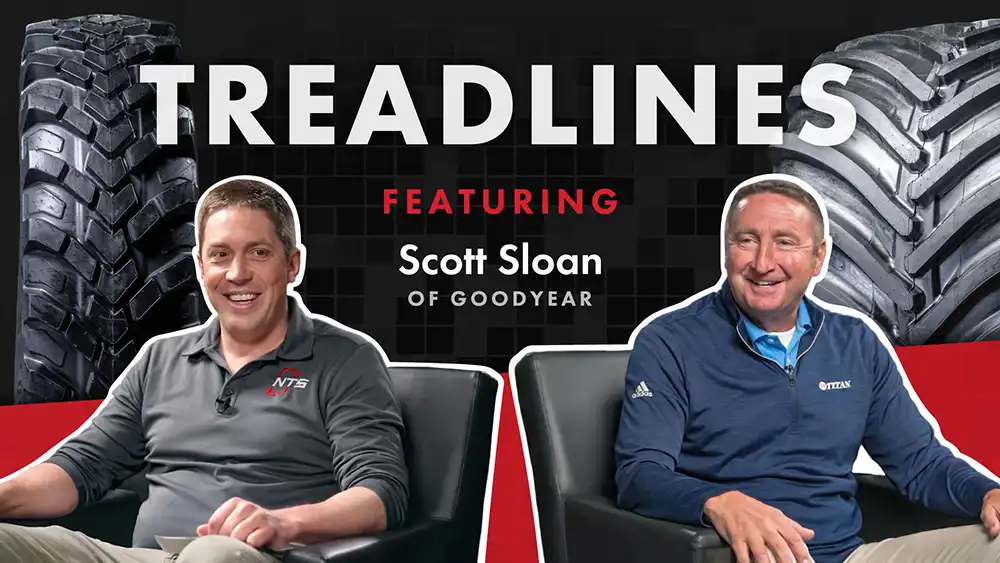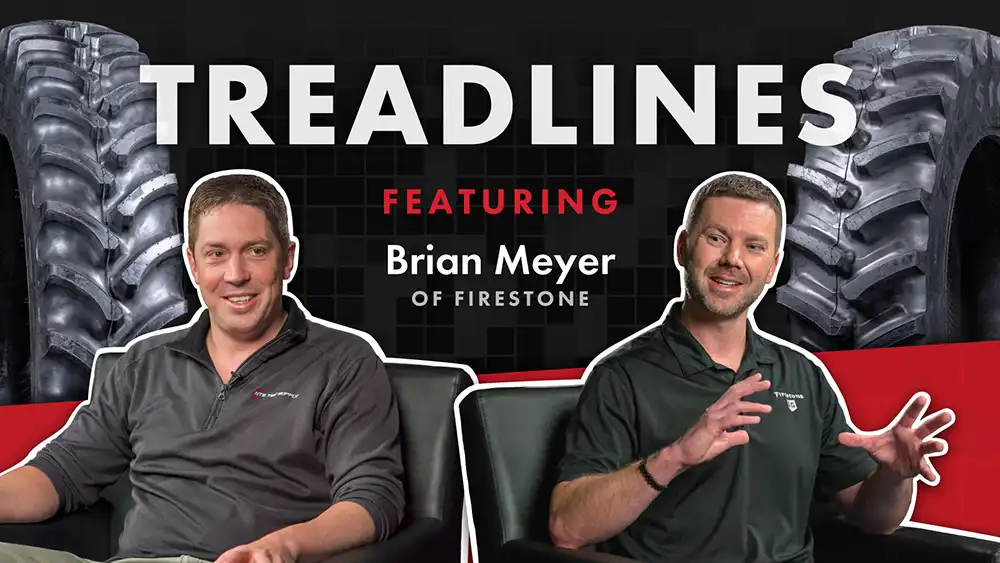Firestone is one of the most iconic names in American tire history, both on the highway and in the field. The company’s roots in agriculture stretch back to the 1930s, when founder Harvey Firestone led the charge to replace steel tractor wheels with rubber. His campaign to "Put the Farm on Rubber" helped revolutionize farming. Today, Firestone continues to serve American farmers alongside its parent company, Bridgestone.

Made in the Midwest: Firestone's Manufacturing Legacy
Firestone tires are a familiar sight on farms across the country, and for good reason. About 90% of Firestone’s ag tires are manufactured at its Des Moines, Iowa plant, which has been in operation since 1945. After acquiring Firestone in 1988, Bridgestone continued investing in the brand, including a major factory upgrade in 2012. In fact, Bridgestone-branded ag tires will also be manufactured at the Des Moines plant in the coming years.
Learn More: Bridgestone Tractor Tires Arrive in North America
Because they’re made in the Midwest near to several major equipment factories, Firestone tires are a common sight on new tractors and combines rolling off assembly lines. And here’s something you might not know: For over 15 years, Firestone has used American-grown soybean oil in its rubber compounds—another way in which the company supports American farmers.

Firestone Farm Tires: Positioned as Premium
Bridgestone markets its Firestone- and Bridgestone-branded tires as premium products. One of Firestone’s signature technologies is AD2, the company’s proprietary name for its IF/VF tire technology. These tires can carry the same load as standard radials at significantly lower pressures—20% lower for IF, and 40% lower for VF—helping to reduce soil compaction and improve machine performance. Firestone emphasizes that it extensively tests its tires at low pressures under load to ensure real-world durability.
Although Firestone doesn’t disclose every technical detail, the company uses high-end materials—premium rubber compounds, steel belts, and heat-mitigating designs—to help its tires last longer under harsh field and road conditions.
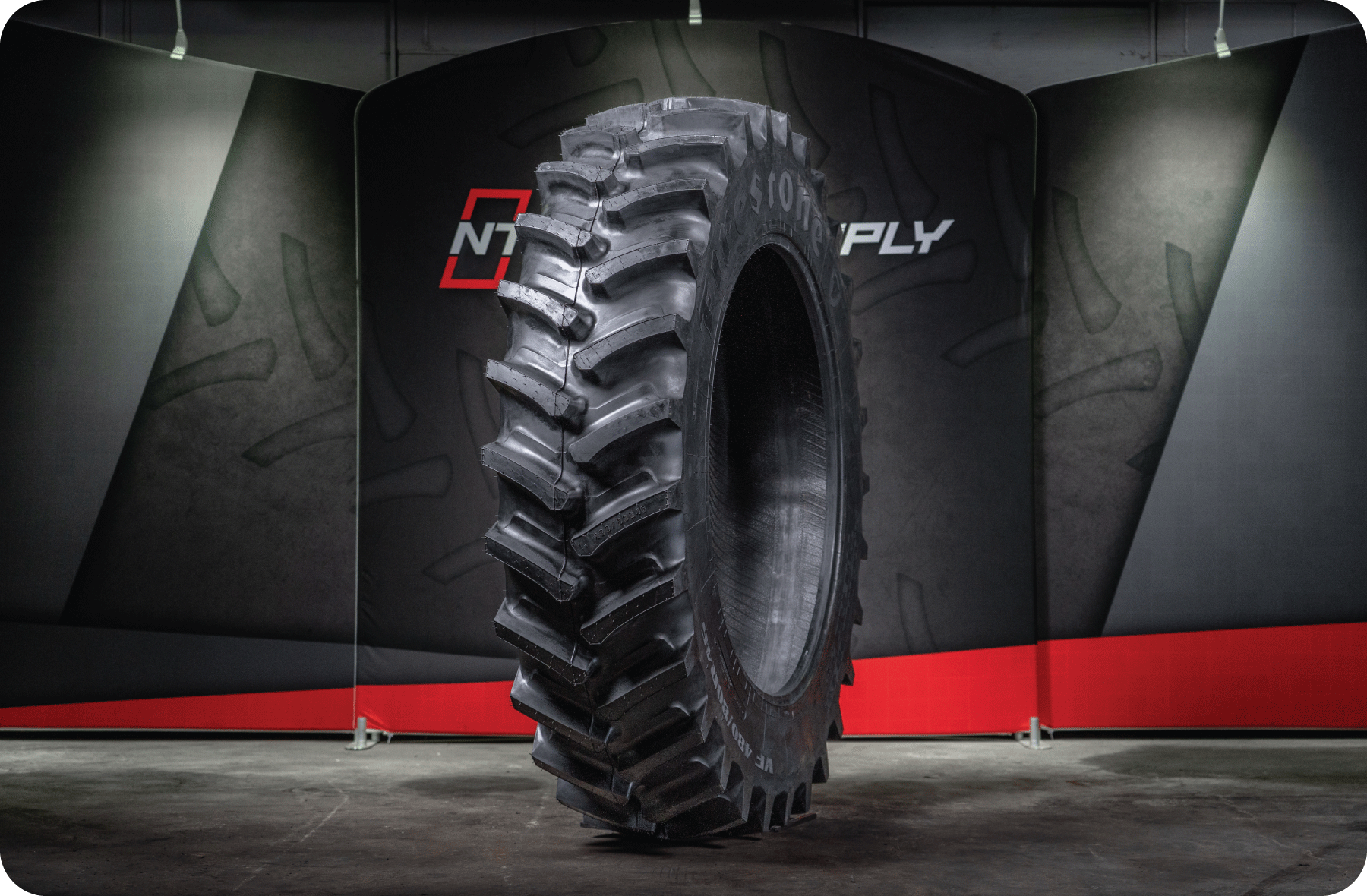
Firestone’s Iconic 23-Degree Tread Bar
Firestone first introduced its iconic 23-degree tread bar in the 1950s, back in the old bias tire days, to maximize pulling performance. If you wanted the absolute maximum amount of traction out of a tire, you’d design a tire with a zero-degree tread bar, like a bulldozer track. That would work in real soft, loose soil. However, on the road, it would shake your tractor apart. For the best road performance, you’d want a 90-degree bar, or tread ribs that wrap around the tire in the direction of travel. In the field, though, that would be a disaster.
This is how the 45-degree agricultural tread bar was invented—it’s the basic tread angle that almost all companies run with. According to Bill Durivage from Firestone, the 23-degree bar leans more toward the traction or in-field performance end of the spectrum. The 23-degree bar sacrifices a little bit of wear performance and ride comfort to provide excellent traction in the field. Because of the bar geometry, you’re going to have more lugs on the ground at any given time in a 23-degree bar than you would in a 45-degree bar.
Our Review: 23- vs. 45-Degree Tread
Here’s our take based on decades of experience: For mid-size tractors, especially in dry conditions, the 23-degree bar delivers excellent traction. But it has a couple of limitations: For medium-horse tractors that were working around the yard or doing fieldwork such as planting or tillage, the 23-degree design was terrific. Especially in dry conditions, a 23-degree tire would help dad or grandpa’s tractor pull like crazy.
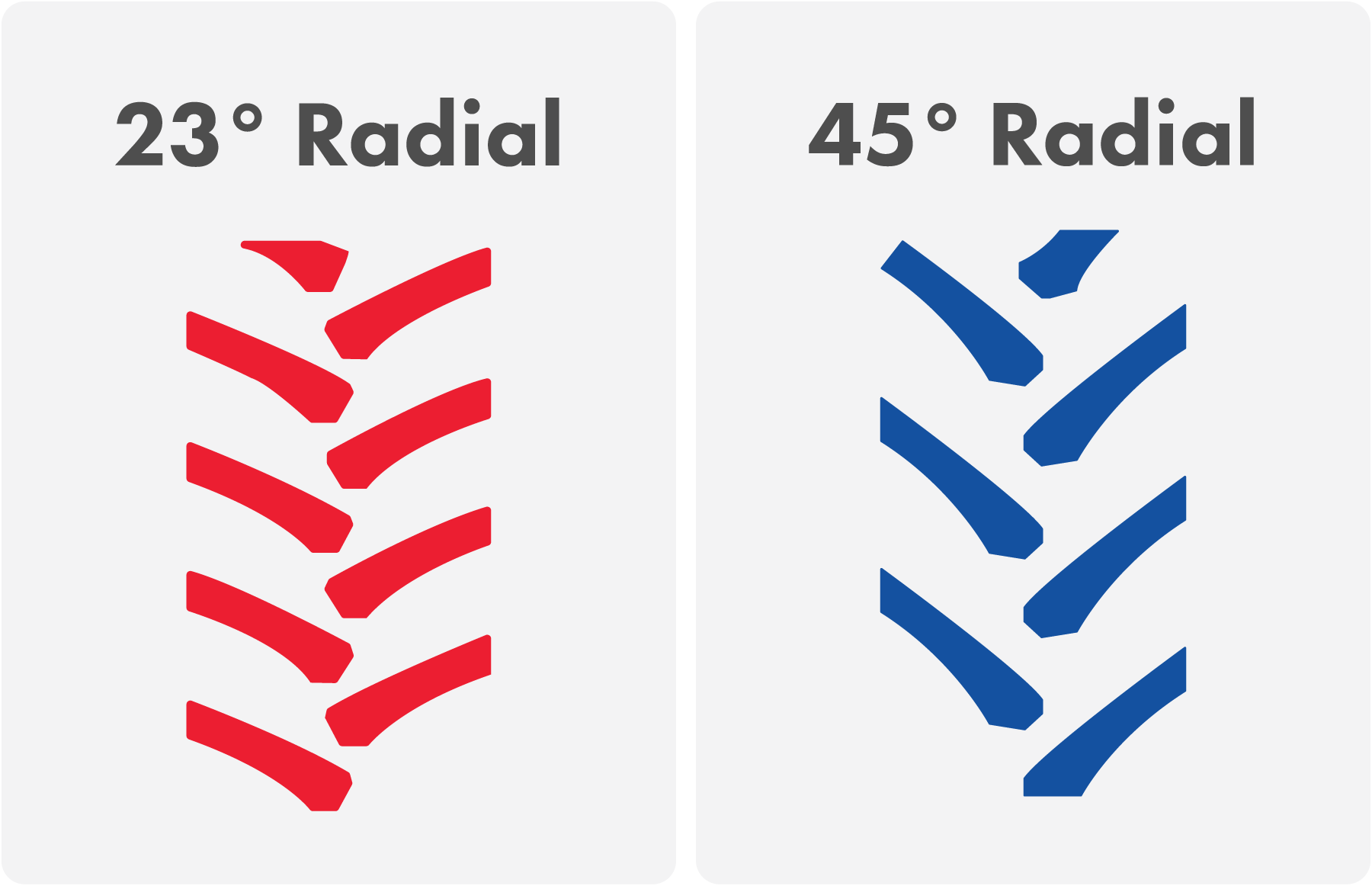
There are a couple of situations that can spell trouble for 23-degree tread, however. Number one is soggy field conditions. In our experience, we’ve found that a 45-degree tread will clean out better. Number two is long-distance roading. Equipment has grown up over the years and become much larger and heavier. We’ve found that the 23-degree tread can wear very quickly under high-speed roading conditions. This is one reason that Firestone launched the Maxi Traction line.
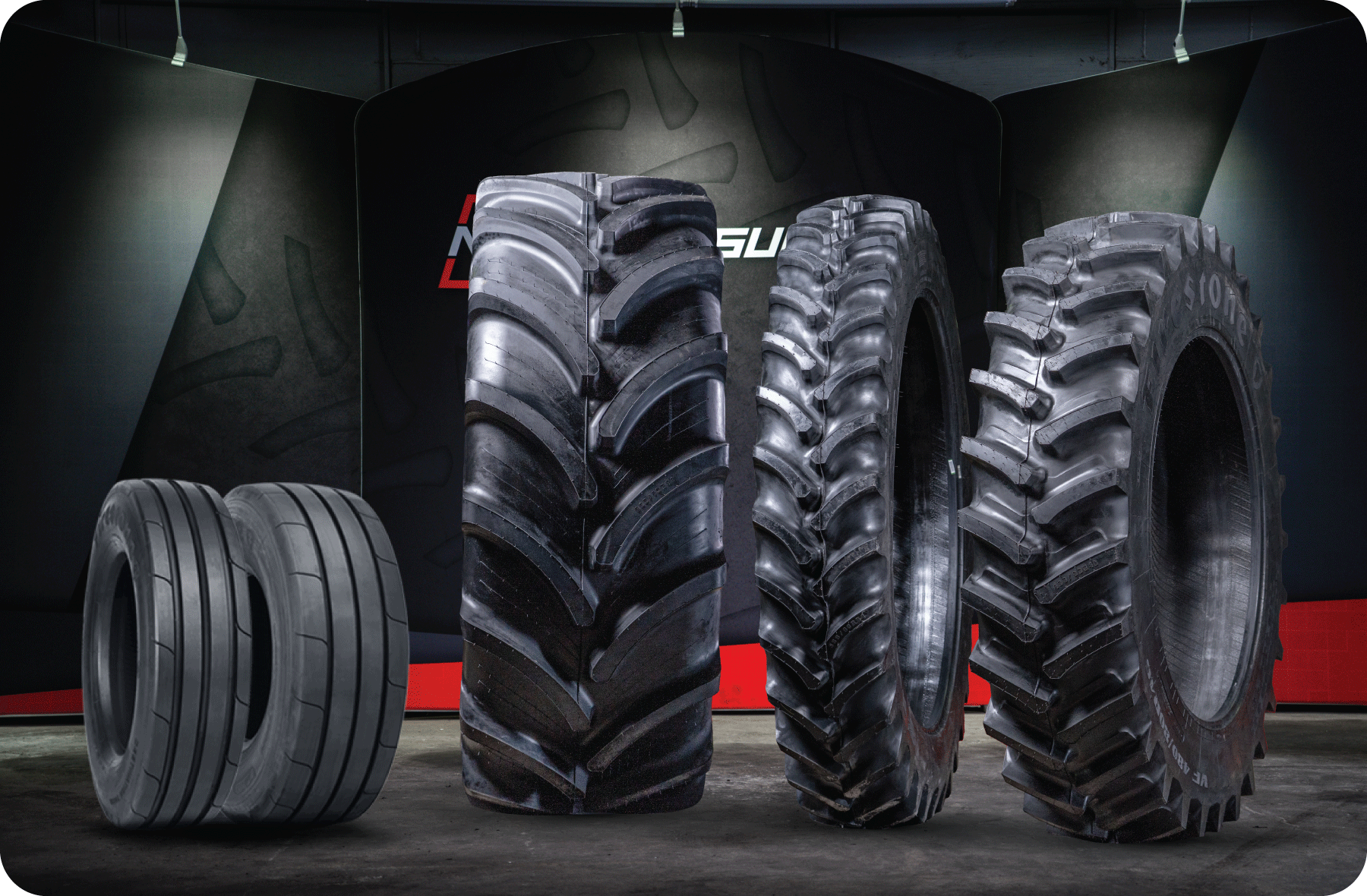
Shopping Firestone: Segment First, Then Size
Before we get into the tires themselves, there’s one more general point about Firestone’s product line to consider: Firestone’s product portfolio is segment based. Some manufacturers have entire product lines that are VF-rated, for example. With Firestone’s tires, you’ll find the AD2 tire models mixed in with standard radials under one product name. For example, you can buy a 800/70R38 Maxi Traction in standard, IF, and VF radial versions. So, when shopping for a Firestone tire, you’ll want to shop by segment first and then by size to figure out what’s available for your particular machine. If you want to shop the easiest way, you can always give us a call and talk with one of our tire experts. We’ll be able to find the best option for your needs before you can say “23-degree tread bar.”
Firestone Maxi Traction: Built for Big Tractors
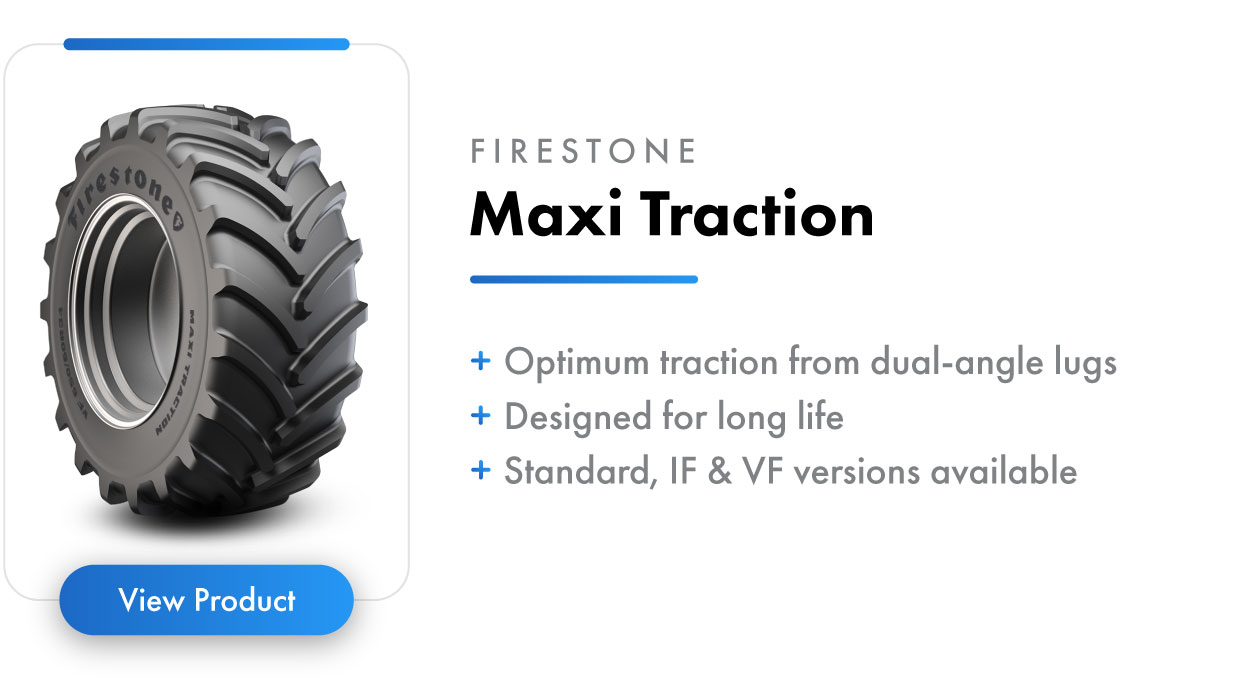
To spin through Firestone’s product line, we’ll begin with the Maxi Traction—the brand’s solution for today’s high-horsepower tractors. As you may know, Firestone is famous for its 23-degree tread bar. The Maxi Traction is one of the company’s tires that has an R-1W 45-degree bar with a dual-angle lug design. The consistent bar width and the bar overlap in the center of the tread is intended to improve the tire life and resist irregular wear. According to Firestone, the uniform bar width also helps distribute the machine’s load evenly across the tire’s footprint. As with several of Firestone’s tire models, the Maxi Traction line includes standard, IF, and VF rated radials. In VF form, we love these tires on combines as well as their intended fitment on high-horse tractors.
Radial Deep Tread 23 Degree: Top End Lugging Power
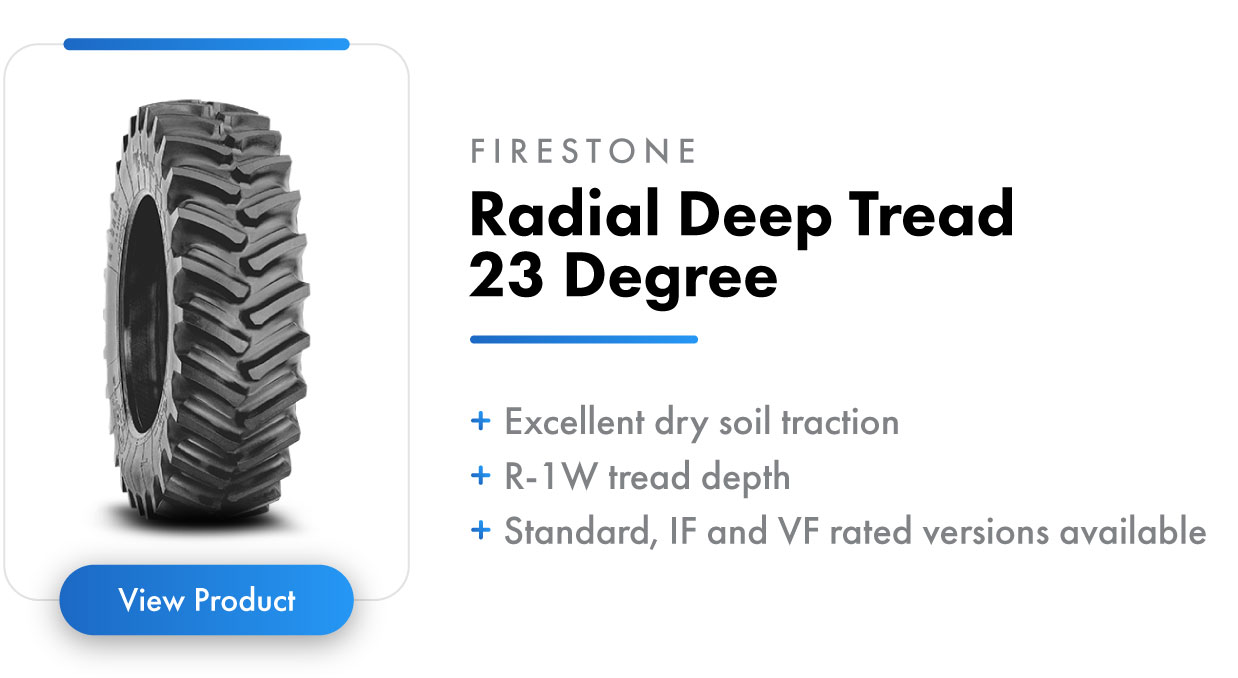
Along with the Maxi Traction, the Radial Deep Tread 23 degree is one of Firestone’s top-end tires and sports an R-1W tread depth. For the Radial Deep Tread 23 Degree in particular, Firestone also designed an extra-wide tread, maximizing the width of the footprint and bars on the ground when compared to the overall section width of the tire. Keep in mind that you’ll find standard, IF, and VF sizes in the Radial Deep Tread 23 degree line. You’ll often find this tire as an OE fitment on John Deere row-crop tractors, with Maxi Tractions on the front axle to optimize steering performance and withstand the extra revolutions of the front axle.
Radial All Traction 23 Degree & FWD: Basic Tractor Tires
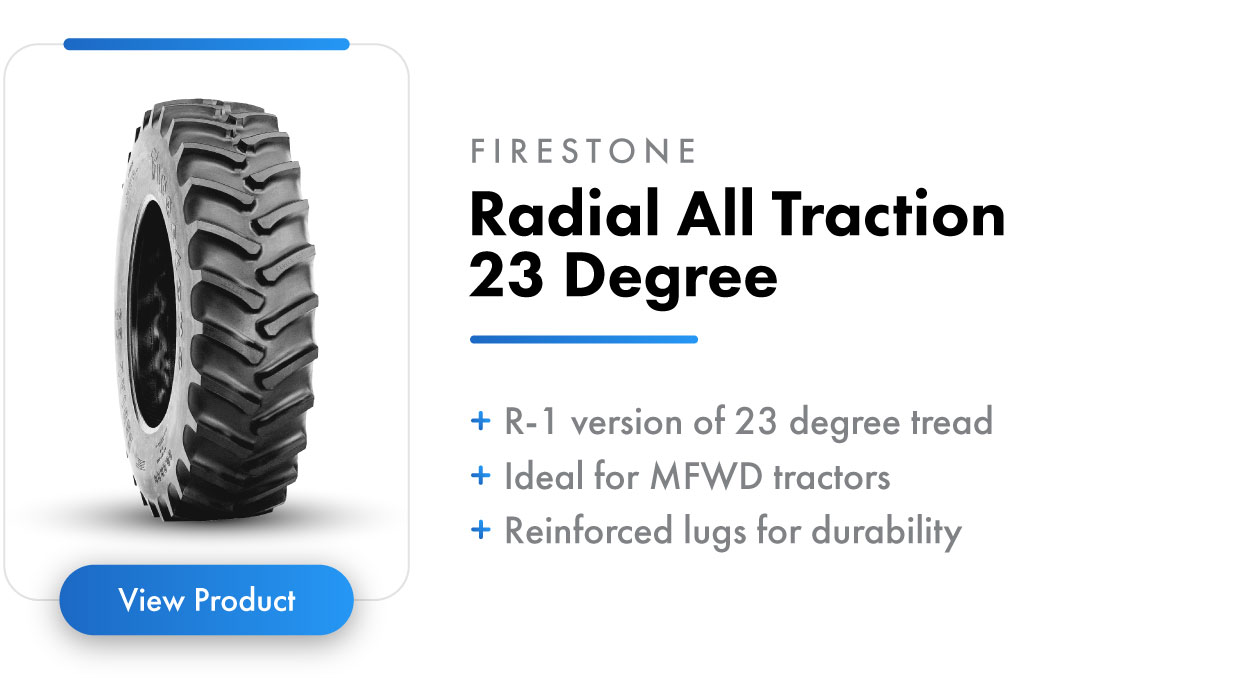
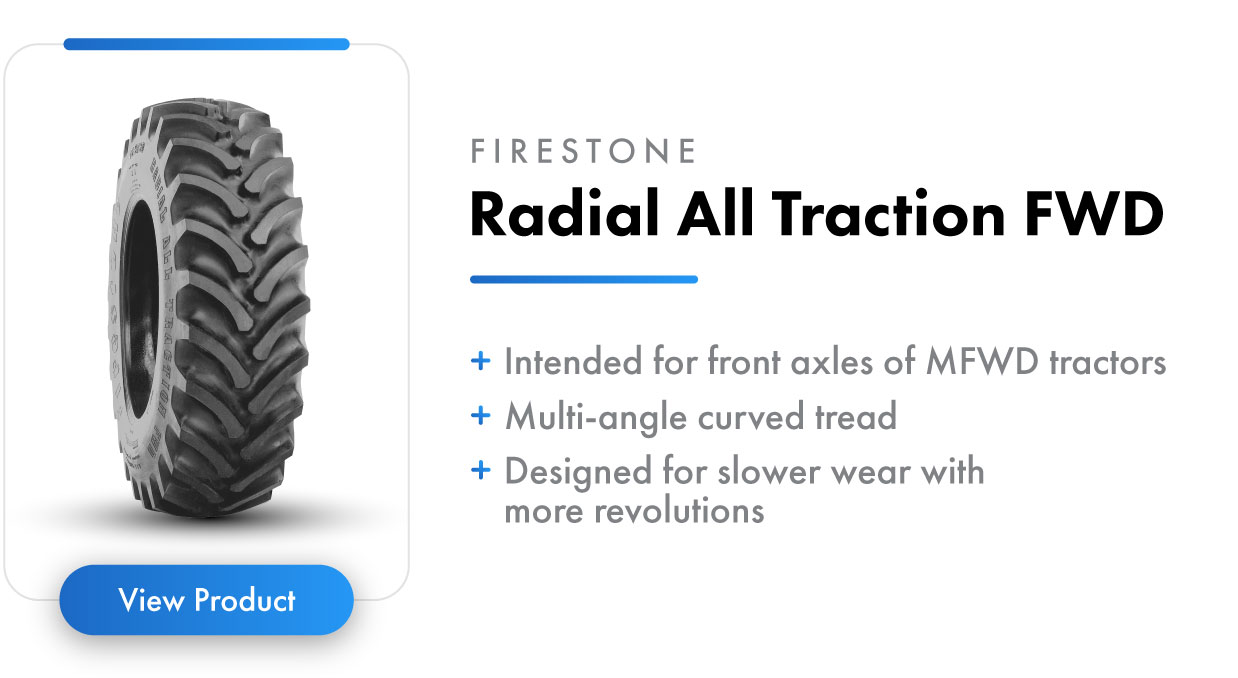
The Radial All traction 23 Degree features the same basic tread design that is found on the Deep Tread 23 Degree, with a couple of differences. One, this tire is a R-1 tread depth. Two, there is also one more pair of tread bars on this tire. Its partner in traction, the Radial All Traction FWD, is purposely designed to be mounted on the front axle of mechanical front wheel drive tractors. It has a lower void ratio, or more bars, when compared with the Radial All Traction 23 Degree, so there’s more rubber built into the tire. The idea is to try to have the fronts and rears wear out at the same time. You have more revolutions on the front axle and more wear from pulling while turning, and the Radial All Traction FWD is designed to compensate for this. In 2023, Firestone updated the FWD by incorporating new materials into the tire and increasing the load ratings of the tire to adapt to today’s larger and heavier tractors.
The Radial All Traction RC: VF Sprayer Tire
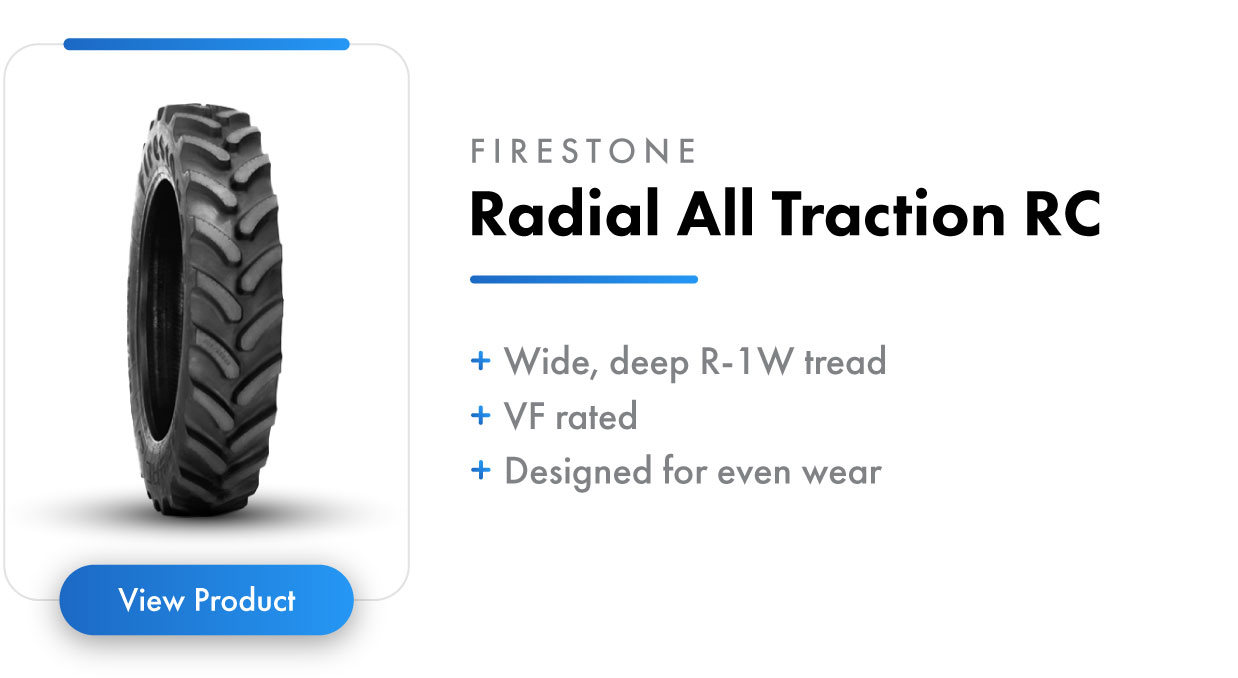
Sprayer tires need to be a special breed, because today’s sprayers are heavier than ever and travel more miles every season to boot. The Radial All Traction RC is Firestone’s answer to this challenge. Firestone offers the tire in high-volume sizes with VF ratings across the board. The tire features very wide, heavy-duty lugs, which are intended to provide even wear and longer tire life overall. It’s also one of the few sprayer tires that features a deeper R-1W tread. When designing the tire, Firestone’s goal was to maximize the amount of rubber in the tire to prolong its life. We’ve also mounted the All Traction RC on the rear axle of row crop tractors in dual or triple configurations.
Our initial experience with the RC has been positive, and it seems to deliver on its promises. In the sprayer market, we still feel as if the Michelin SprayBib is king, especially when it comes to wear life on the road. And the Agriflex+ 354 from Alliance continues to earn more respect from both our team and our customers for its durability.
The Radial All Traction DT: Still a Strong Combine Option
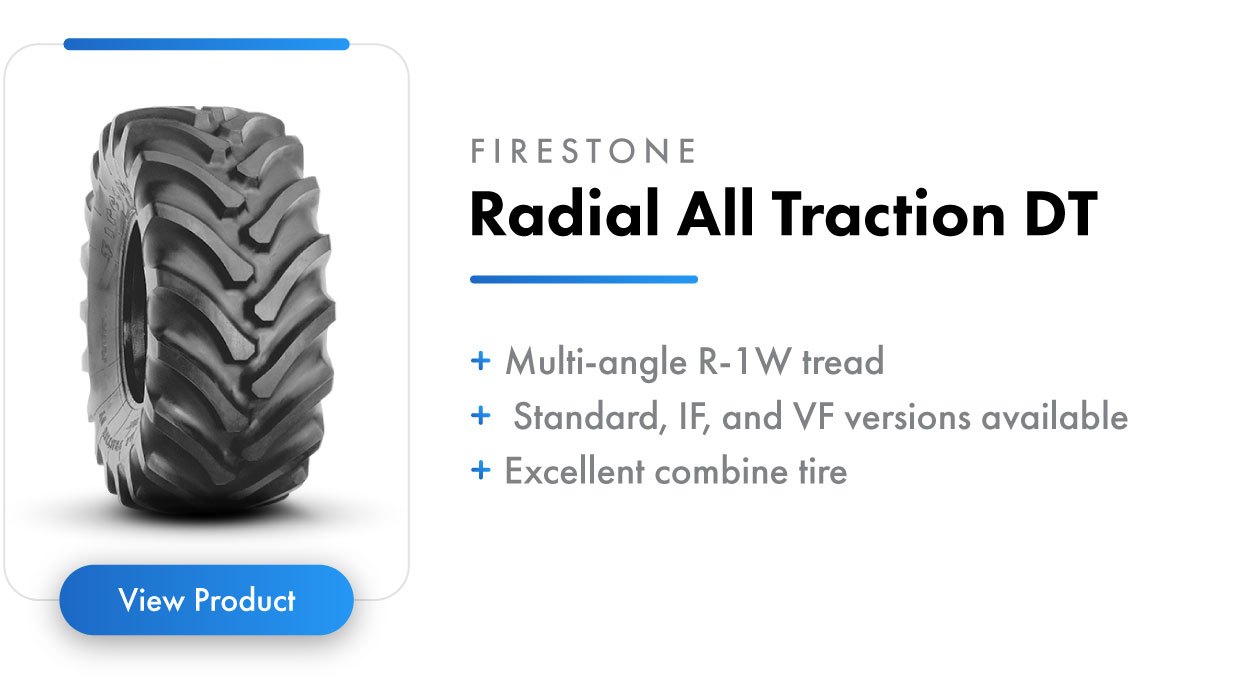
The Radial All Traction DT has been around since 1993 and is primarily mounted on combines and tractors. It features a swooping tread design with a knobby center tread. Like the Maxi Traction, it’s a 45-degree bar. According to Firestone, the Maxi Traction’s tread has the edge when it comes to tire life and resistance to irregular wear. While Firestone has been moving sizes away from the DT line to the Maxi Traction line, the Radial All Traction DT still has IF and VF options available and is available at a slightly lower price point. From our perspective, the Radial All Traction DT is still a great combine tire.
The Radial 9000: Aging Out of the Tractor Tire Lineup
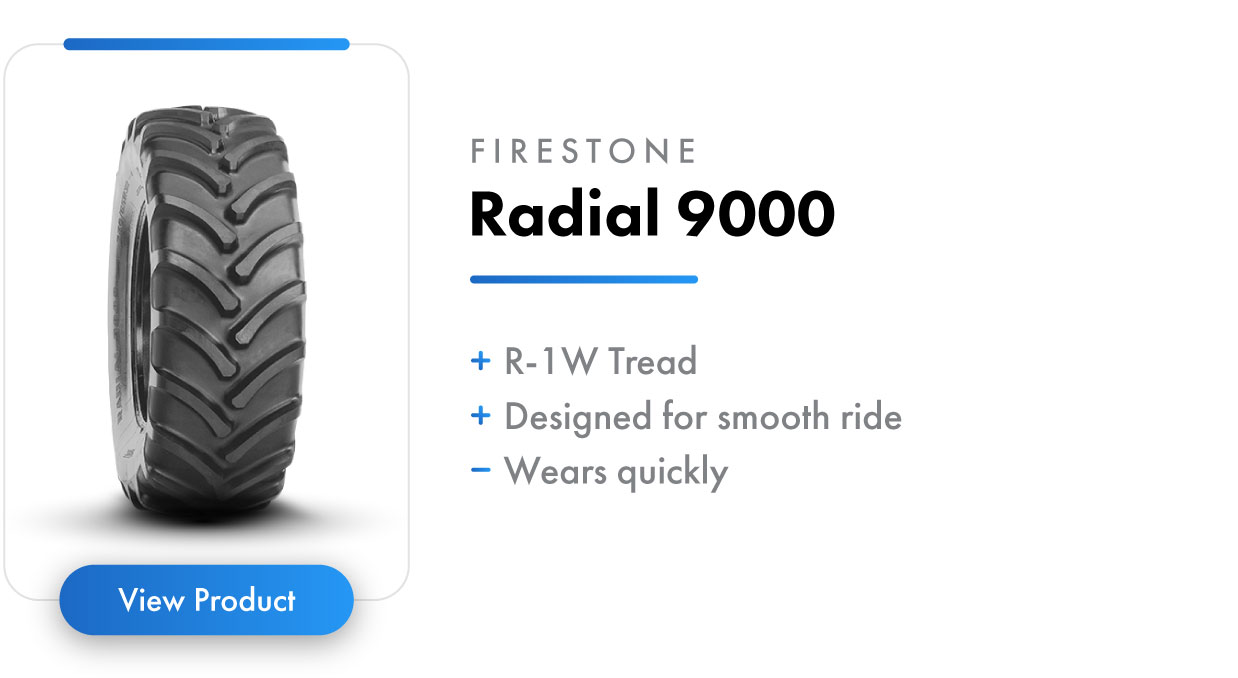
The Radial 9000 has been in Firestone’s lineup since 1997 and is offered in narrow sprayer and tractor sizes. It’s essentially an older version of the Maxi Traction with a dual-angle R-1W tread that has a knobbier nose and a slight overlap at the tread’s center. As with the Radial All Traction DT, Firestone is transitioning sizes away from the 9000 in favor of the Maxi Traction.
In our experience, you’d be much better off with an All Traction RC or another tire for your sprayer. We’ve found that the 9000 performs poorly and wears fast with significant roading. With today’s sprayers traveling farther and faster than ever, this tire is no longer up to the task.
Performer Evo: An Entry-Level Tractor Tire
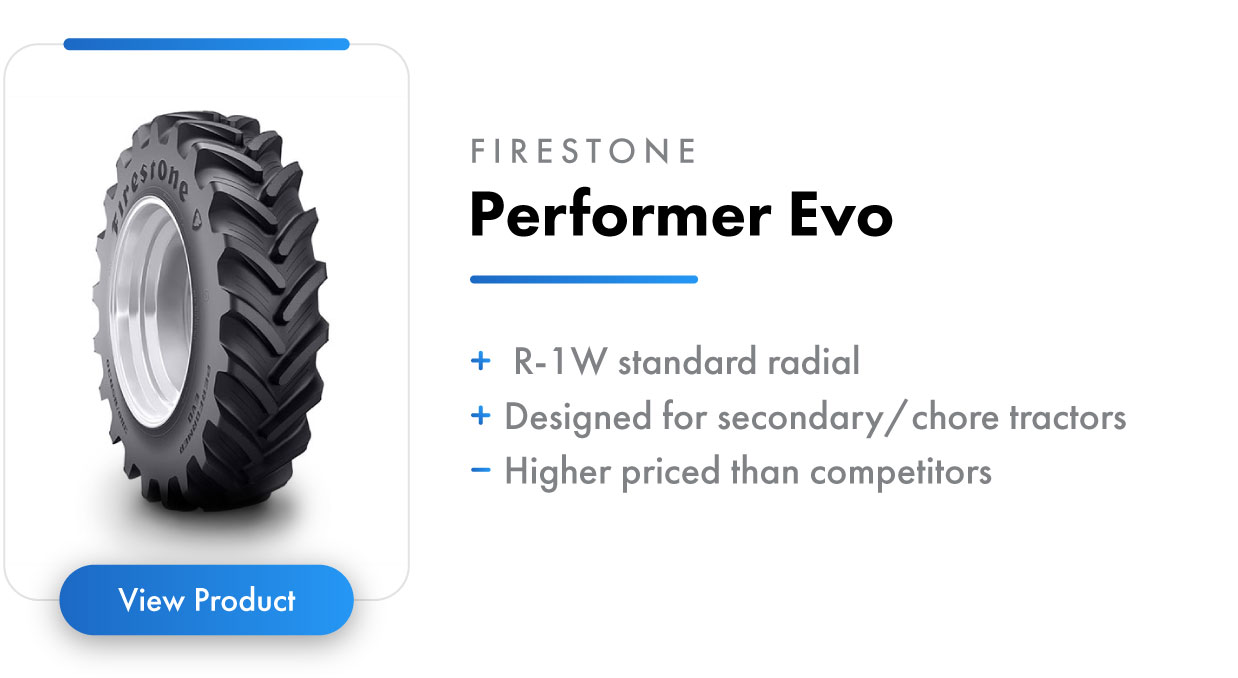
The Performer Evo is an entry-level tractor tire designed to compete with the plethora of foreign value tires in the ag market. According to Bill Durivage, Firestone incorporated elements of the Maxi Traction’s design into the Performer Evo. It does have an R-1W tread depth like the Maxi Traction and the Performer Evo is also available in a 23-degree version, but only in two sizes for mounting on the rear axle of a tractor.
The Evo is not suitable for mounting on your larger tractors that are going to drive your farm’s productivity—your planting tractor or the tractor you’re using for heavy tillage. But if you’re looking for an American-made budget radial for a secondary or chore tractor, the Performer Evo may fit the bill. It’s really tough to put this tire near the front of the pack, however, because there is a lot of competition in the Evo’s price range. Not to mention, we can piece together a decent set of used tires for less money if price is a farmer’s primary concern and we’re dealing with a low-hour-per-year tractor that doesn’t need to do heavy pulling.
Destination Farm: The Best Implement Tire You Can Buy?
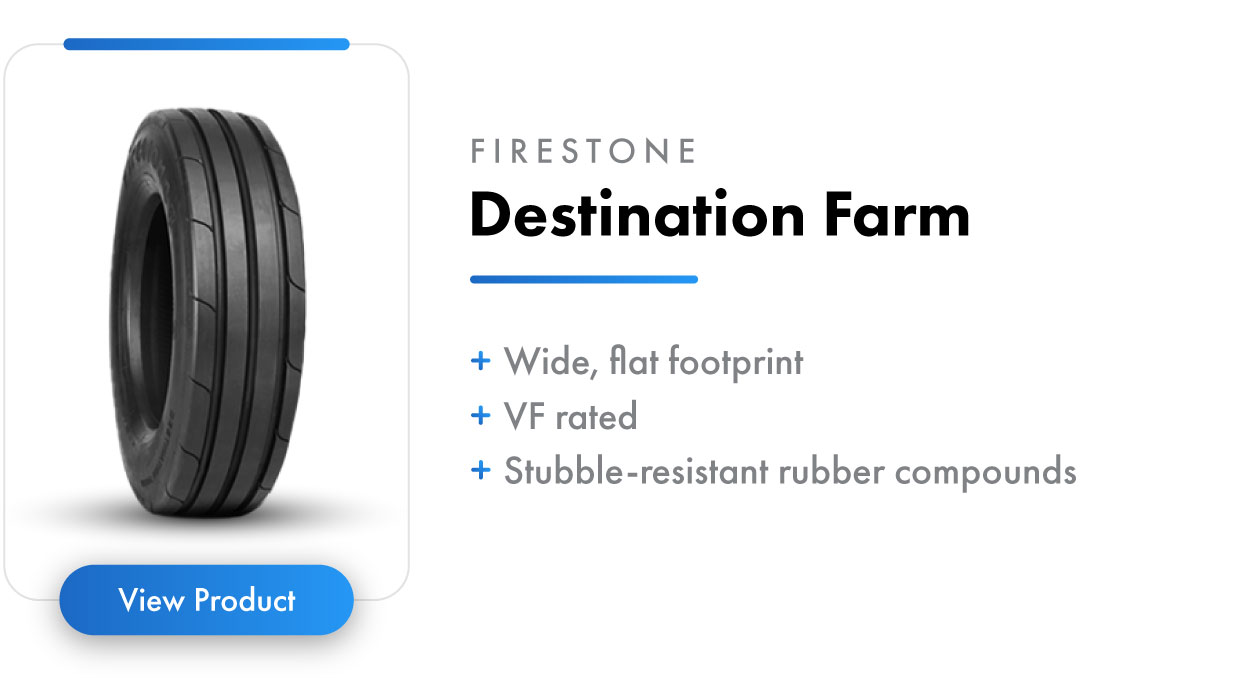
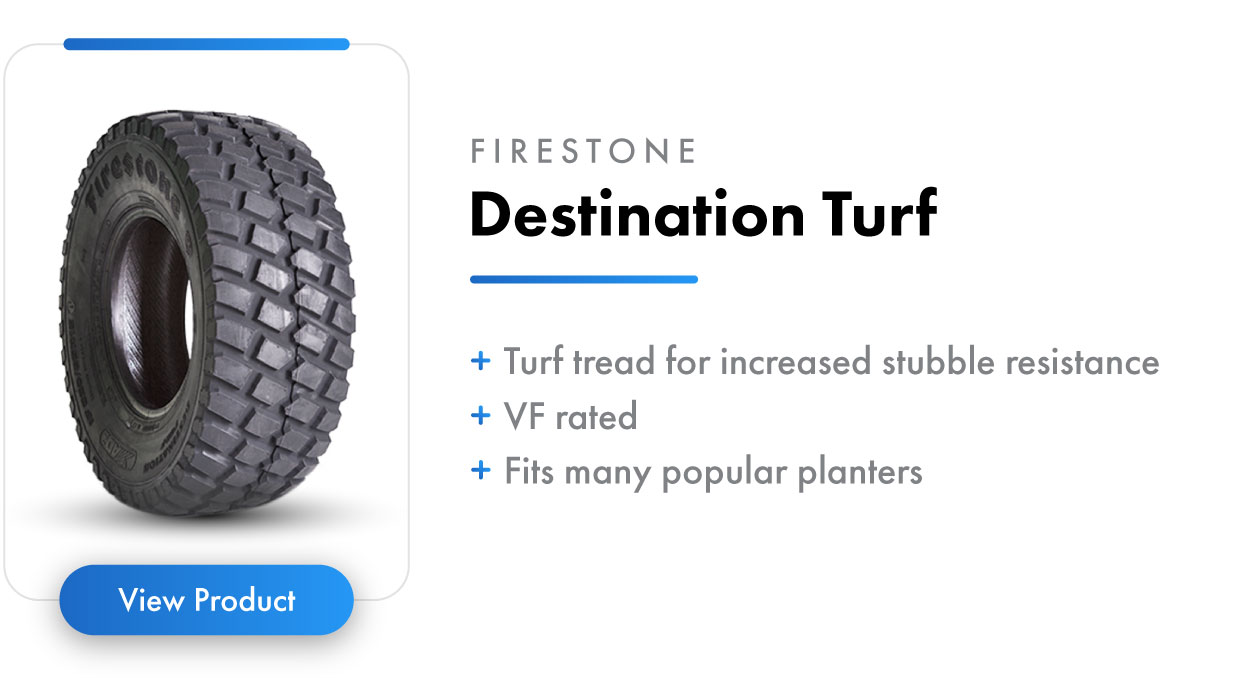
The Destination Farm and Destination Turf are two of our favorite farm tires. Spendy? Sure. But keep in mind that these tires are mounted on machines that have the ability to either boost or sink your farm’s profitability. For example, the tires’ wide, flat footprints can help you and your center-fill planter avoid yield-robbing pinch-row compaction, especially when you also equip your planting setup with a central tire inflation system.
Learn More: Why You Need a Central Tire Inflation System for Your Planter
The Destination Farm features a standard rib tread, while the Destination Turf features a lug tread designed to deflect stubble and increase tire life. Both Destinations put down a wide, flat tread thanks to their VF rating. In the last couple of years, Firestone has upgraded the rubber compounds in these tires to provide even better stubble resistance. While the Destinations are now VF across the entire range of sizes, you’ll still find some older IF-rated models in tire shop inventories (and on the used market).
Destination Cart: A Grain Cart Tire Designed for Soil Protection
The first Destination Cart tire rolled off Firestone's production line in July of 2024. At the time we compiled this article, it was available in only one size—an IF1050/50R32CFO. The tire’s shallower R-1 tread depth and wide-spaced lugs are designed to be easier on the soil and not dig into the ground when turning on the headlands. We’ll keep an eye on the Destination Cart and see if it makes it onto our list of top grain cart tires in the future.
Firestone Farm Tires Warranty Support
What happens if you have an issue with a Firestone tire? For radials, except the Performer Evo, the brand offers a 9-year warranty. The first two years are full coverage if the tire is worn less than 25 percent, and the rest of the warranty offers pro-rated coverage. The Performer Evo has a 6-year prorated warranty, with full coverage offered during the first year of service, provided the tire isn’t worn more than 10 percent. The same goes for Firestone’s bias tires.
Firestone also offers 3 years of stubble damage warranty coverage and 2 years of field hazard coverage, both prorated from day one. To qualify for the stubble damage warranty, a farmer has to:
- Run tires between the rows.
- Use mechanical devices to stop stubble.
- Make the first tillage pass parallel to the rows.
So that’s the fine print, but you’re probably wondering, what is it like dealing with Firestone when it comes to warranty claims? Well, you might have better luck buying a lottery ticket or two. All manufacturers have become more difficult in the warranty department over the past several years, but we’d rate Firestone solidly in the very difficult category. If you do have a warranty claim, you should know that we have an in-house warranty department that handles farmers’ warranty claims from any brand. We’re happy to take that headache off your plate. And, trust us, it’s a headache these days.
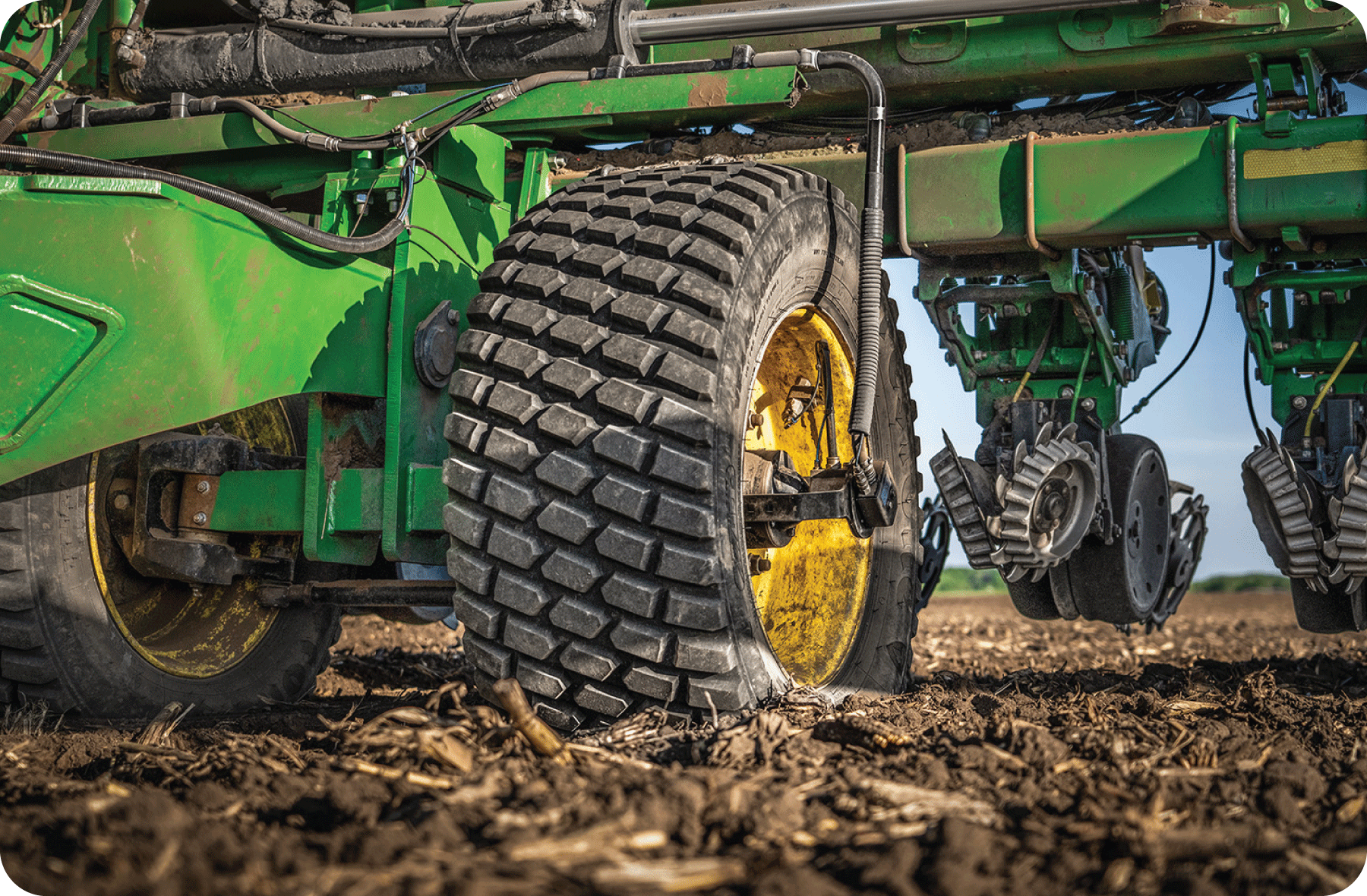
Where do Firestone Tires Rank?
Is Firestone a “good” tire brand? Firestone is one of those American brands that just makes you feel good. The company manufactures the majority of its tires right here in the Midwest and remains one of the most popular OE tire brands in the market. And we have Firestone to thank for kicking the pneumatic tire party off in the 1930s.
The reality is, however, that the agricultural tire market is bursting with competitive options in every segment today. Is being American-made a big plus for our customers? Possibly. But many times the discussion comes down to price versus performance. And it feels like some of Firestone’s competitors have set the bar higher for innovation and quality per dollar at this point in time. In other words, there are competing products out there where we feel you get more bang for your buck. Firestone is still a sought-after tire and we’re glad to offer its products and the new Bridgestone line. But we also feel that the brand has some catch-up to do if it’s going to regain its place at the top of the industry.
The easiest and fastest way to find the Right Tire System for your farm is to call and talk to one of the ag tire experts at NTS Tire Supply. We sell all brands of agricultural tires and will recommend the brand and model that’s right for your needs and budget. Because we’re here for one reason only, and that’s to Drive Your Farm Forward.

.png)
.jpg)




